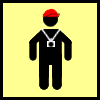Big Wallaby wrote:I like roundabouts, if they're properly designed. For instance, they're on a road with many of them, they're designed so you don't spend half a day waiting to get onto them, people cooperate and let you in...
Okay, after that last one, maybe they're not so great for here. Especially bad for Orlando!
I think New England is the rotary (our name for roundabouts) capital of the country. If you know the laws of how to drive through them (i.e. if someone is *in* the rotary, they always have the right of way), you're fine. The problem is when you get someone who doesn't really want to enter the rotary, they just want to scoot over to the next street over, and they don't yield.
I actually read recently that rotaries are actually safer than your typical intersection in terms of accidents. Accidents in 4-way intersections typically are dangerous broadside collisions that often involve serious injury. Accidents at rotaries are usually more of a fender-bender with glancing side-swipes that cause damage to the car, but not the occupants.
Then you get traffic designers with good intentions who re-design rotaries that worked fine before, but then can't design good signs showing what you're supposed to be doing. Here in Worcester, they're in the middle of redoing a large rotary in front of the train station. It's two lanes all the way around, with two lanes at each approach into it. It took me a few drives through it to realize that the signs they posted are trying to say that you use the right-hand lane if you're heading for the first or second exit out of the rotary, and the laft-hand lane if you're heading for the second or third exit out of the rotary... But you glance at the sign the first time, and it's just a jumble of circles, lines and arrows...
-Rob



